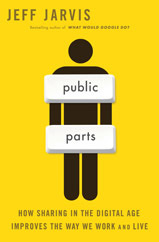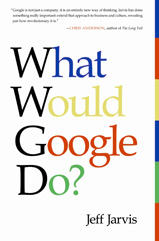 *
*In 2006, Jürgen Habermas, the preeminent theorist of the public sphere, spoke of the internet for the first time, only in a footnote, all but dismissing the net as “millions of fragmented chat rooms.” Many have waited for more. Now, in a paper recently published and translated, Habermas finally reflects on the internet and its impact on public discourse.
Habermas now calls the internet “a caesura in the development of media in human history comparable to the introduction of printing,” an “equally momentous innovation” to the invention of movable type, and a “third revolution in communications technologies” whose result is “the global dissolution of boundaries” as “the communication flows of our garrulous species have spread, accelerated and become networked with unprecedented speed across the entire globe and, retrospectively, across all epochs of world history.”
As someone who has a book positing just that coming out in June — The Gutenberg Parenthesis: The Age of Print and Its Lessons for the Age of the Internet (preorder now) — I am gratified, indeed relieved not to be alone. In my book and now here, I will dispute Habermas. Agree or disagree with his provocations, though, they have a way of helping to clarify one’s own thinking. (Sadly, Habermas’ paper is behind high academic paywalls festooned with barbed wire — $351.83 to get inside the special issue — so linking to it does little good, and I am not up to the task of summarizing all he has to say. Instead, I will offer a few reactions and debates of my own about publics, media, and speech.)
Habermas has long sought the substantiation of the public sphere. Many say that ultimately eluded him in his seminal work, in which he asserted that a bourgeois public sphere mediating between populace and state emerged in critical, rational and inclusive discourse in the coffeehouses and salons of England and Europe. Problem is, that debate was far from inclusive, as it was open only to the privileged patrons of the establishments, excluding women and people of lower classes. Neither was the discussion necessarily rational, as coffeehouse historians Aytoun Ellis, Brian Cowan, Markman Ellis, and Lawrence Klein amply document. Nancy Fraser’s feminist critique of Habermas’ theory is convincing: “We can no longer assume that the bourgeois conception of the public sphere was simply an unrealized utopian ideal; it was also a masculinist ideological notion that functioned to legitimate an emergent form of class rule…. In short, is the idea of the public sphere an instrument of domination or a utopian ideal?”
Today Habermas seeks his public sphere on the internet, suggesting that “at first, the new media seemed to herald at last the fulfillment of the egalitarian-universalist claim of the bourgeois public sphere to include all citizens equally.” He has a habit of proposing the emergence of a public sphere and then simultaneously mourning its passing. As for the seventeenth- and eighteenth- public sphere, he lamented its denigration via mass media and the welfare state. As for the networked public sphere of present day, he complains of echo chambers, the dissolution of boundaries, the blurring of private and public, and social media fragmenting this new institution as soon as it appears.
But there never has been and never will be a singular public sphere; that is the fundamental fallacy of the theory. Instead, there are multiple, overlapping imagined communities, publics, institutions, and markets that vie for power and attention through debate, privilege, and protest. Michael Warner proposed counterpublics: the idea that some publics “are defined by their tension with a larger public.” Fraser wrote that alongside Habermas’ bourgeois public “there arose a host of competing counterpublics, including nationalist publics, popular peasant publics, elite women’s publics, and working-class publics. Thus there were competing publics from the start, not just in the late nineteenth and twentieth centuries, as Habermas implies.”
Habermas repeats the mistake much of mainline media make when he interprets January 6 as “the emotive response of voters who for decades have lacked a sense that their ignored interests are taken seriously by the political system in concrete, discernible ways.” He blames political elites, saying they had “for decades disappointed the legitimate, constitutionally guaranteed expectations of a significant portion of citizens.” No. It’s not that the insurrectionists — white men — had been neglected by the power structure; they were that power structure. It’s that white men see their power slipping away at the hands of so many counterpublics — read: people of color and women — who had been neglected and now may finally be heard via the internet. As a European, Habermas fails to account for race in the public Reformation (#blacklivesmatter) and Counter-reformation (MAGA) occurring now in America.
In Habermas’ worldview, there is today a public sphere online that decomposes into “competing public spheres” and “shielded echo chambers.” (Note well that the echo chamber is a trope with little empirical data and research to support it. See Axel Bruns’ Are Filter Bubbles Real? and its answer: No.) Fraser suggests the opposite, a public not decomposing but growing out of “a multiplicity of publics” as “an advance toward democracy” to “promote the ideal of participatory parity.” She warns: “Where societal inequality persists, deliberative processes in public spheres will tend to operate to the advantage of dominant groups and to the disadvantage of subordinates. Now I want to add that these effects will be exacerbated where there is only a single, comprehensive public sphere.” That is, the vision of a single public sphere brings with it the presumption of norms and standards set on high, from those with the power to impose their vision upon all. (See, for example, journalistic objectivity — and Wesley Lowery’s critical op-ed exposing that institution’s roots in white power.)
Fraser says that with a single public sphere, “members of subordinated groups would have no arenas for deliberation among themselves about their needs, objectives, and strategies.” Fraser labels such groups “subaltern counterpublics.” In André Brock Jr.’s book, Distributed Blackness: African American Cybercultures, which I quote and teach often, he calls Black Twitter a “satellite counterpublic sphere.” All this is to say that rather than imprinting Habermas’ worldview on the internet, it would be more productive to understand the net for what it is becoming and adjust one’s worldview accordingly, not to pursue a single, decaying public but instead to study an interlocking ecology of many publics.
One need also adjust one’s view of media. In his foundational 1962 book, Habermas lamented the damage wrought by mass media on his first public sphere of the coffeehouse. In his current paper, he laments the supersession of mass media by social media and its effect on his new public sphere of the internet. He still imbues in mass media the power — the responsibility, in fact — to shape public opinion. “The function of the professional media is to rationally process the input that is fed into the public sphere via the information channels of the political parties, of the interest groups and PR agencies, and of the societal subsystems, among others, as well as by the organisations and intellectuals of civil society.” He goes farther: “[T]he public communication steered by mass media is the only domain in which the noise of voices can condense into relevant and effective public opinions.” He longs for “a professionalized staff that plays the gatekeeper role.” Habermas says that mass-media journalism “directs the throughput and … forms the infrastructure of the public sphere.”** Extending his electronic imagery, he argues that institutions provide the input, the public receives the output, media throughput. But I say he needs to reverse his wires.
Actually, Habermas made me understand that I have reversed my wires. I now see that the role of media is not to shape public opinion but instead to listen to public opinions now that the internet makes that possible. The goal is not to direct the views of the powerful in institutions toward the public but instead to direct the needs, desires, and goals of citizens to those in power. What has to be shaped is not public opinion about public policy but instead policy to the needs of the public. Whether media have a role in that process — that reversed throughput— is yet to be seen.
Today, media use polls as a proxy for a discerning and disseminating public opinion. Polls are fatally flawed, carrying the biases of the pollster, reducing citizens’ nuanced opinions to preconceived binaries, and warping identities into to prepackaged demographics. As James Carey — whom I also often quote — teaches us, polling preempts the public conversation it is intended to measure. In fairness, it’s all media had: one-size-fits-all publications carrying all-fit-in-one-size polls to represent vox pop.
But the internet changes that, as Habermas acknowledges, “by empowering all potential users in principle to become independent and equally entitled authors.” Now, instead of measuring people in binary buckets, we may listen to them as individuals. Habermas and countless others might consider that the ruin of democracy. He regrets speech occurring “without responsibility” or regulation: “Today, this great emancipatory promise is being drowned out by the desolate cacophony in fragmented, self-enclosed echo chambers.” No, in that cacophony, which media cannot manage, is the opportunity of democracy to hear citizens on and in their own terms, in their own communities of many definitions, as their own publics. That will require a new institution, a media of reversed pipes, to build means to listen well. That does not yet exist.
What shape would that new institution take? On the one hand, I am overjoyed that Habermas acknowledges — as I often argue — that “the new media are not ‘media’ in the established sense.” Yet he then turns around to reveal his expectation that people talking online should meet the standards of media and journalism. He is nostalgic and he is worried. He heralds “post-truth democracy” and regrets the passing of print and even of daily newspapers taking on “the ‘colourful’ format of entertaining Sunday newspapers.” German newspapers are particularly gray. “[T]he dramatic loss of relevance of the print media compared to the dominant auto-visual media seems to point to a declining level of aspiration of the offerings, and hence also for the fact that the citizens’ receptiveness and intellectual processing of politically relevant news and problems are on the decline.” When radio emerged as print’s first competitor, newspapers denigrated the receptivity of ear versus eye and called for the new technology to be regulated, just as Habermas demands that “platforms cannot evade all duties of journalistic care” and “should be liable for news that they neither produce nor edit.” Let us hope the Supreme Court does not read this in its deliberations over Section 230.
At least Habermas acknowledges that this process, whatever its shape and purpose, will take time. “Just as printing made everyone a potential reader, today digitisation is making everyone into a potential author. But how long did it take until everyone was able to read?” He expects speakers online to aspire to the roles of journalist and author, to “satisfy the entry requirements to the editorial public sphere…. The author role has to be learned; and as long as this has not been realized in the political exchange in social media, the quality of uninhibited discourse shielded from dissonant opinions and criticism will continue to suffer.” No. I say we must learn to accept online speech for what it is — conversation — and value it for what it reveals of people’s opinions and for the opportunity to engage in dialog. Habermas is rather befuddled by public spaces that carry the kind of content that used to be reserved for handwritten letters: “they can be understood neither as public nor private, but rather as a sphere of communication that had previously been reserved for private correspondence but is not inflated into a new and intimate kind of public sphere.” Is he not describing Montaigne’s place in the development of print culture?
In the end, I wish for what Habermas desires: democracy underpinned by inclusion and by public discourse as “the competition for better reasons,” as he said a half-century ago. Or as he says now: “I do not see deliberative politics as a far-fetched ideal against which sordid reality must be measured, but as an existential precondition in pluralistic societies of any democracy worthy of the name.” He is an idealist. “The point of deliberative politics is, after all, that it enables us to improve our beliefs through political disputes and get closer to correct solutions to problems. In the cacophony of conflicting opinions unleashed in the public sphere only one thing is presupposed — the consensus on the shared constitutional principles that legitimises all other disputes.” Unless, of course, one is a MAGA Republican, an AfD populist, or the leader of Hungary or Turkey, for whom the goal is not Habermas’ wished-for rational consensus but instead the visceral attractions of hate, fear, power, and insurrection.
Media have failed to get us to Habermas’ promised land. So far, so have so-called social media. Perhaps we have expected too much of either. Perhaps we have expected too much from the mere serving of information. Perhaps media must take on a new role, as educator, for education is the only cure for the ignorance reigning in the land. Or instead, should education take on the role of informing the public after school? (See this recent thread about academics leaving the academy to pursue public scholarship.) Or will we need to create new institutions to serve public enlightenment and discourse, just as we had to await the creation of the institutions of editing and publishing and journalism after the invention of print?
The shape of public discourse is changing radically and trying to pour new wine in an old Weltanschauung will not work. I can hardly blame Habermas for trying to do that, for he has spent a brilliant life crafting his theories of democracy and discourse. I find his effort to understand this new world useful not because I agree but because it focuses my perspective through a different lens. The worldwide network does not corrupt some ideal that was never achieved but instead allows us to imagine new ideals and new paths toward it.
* Not Jürgen Habermas but Dreamstudio’s AI image of him online
** Habermas is oddly italics-happy in his essay; his itals are his. In my book Public Parts, I got in trouble with Habermas adherents for likening his prose to wurst. I cannot pass up the temptation to quote one footnoted and much-italicized sentence of his here: “The lack of ‘saturation’ concerns the temporal dimension of the exhaustion — still to be achieved in the political community and still to be specified as regards its content — of the indeterminately context-transcending substance of established fundamental rights, as well as the spatial dimension of a still outstanding world-wide implementation of human rights.”










